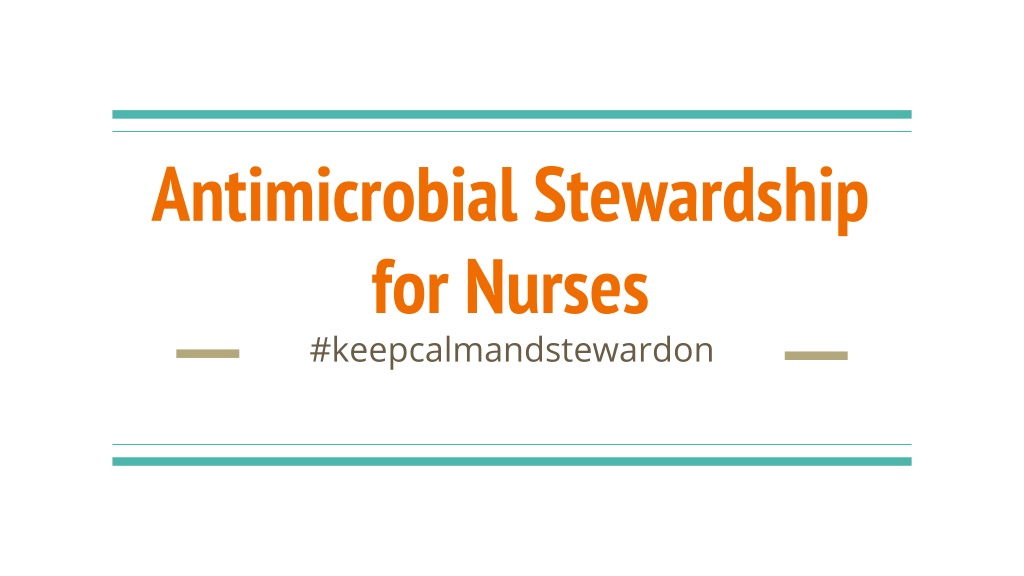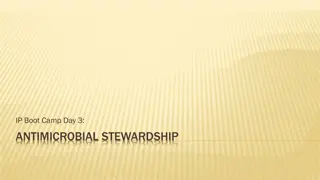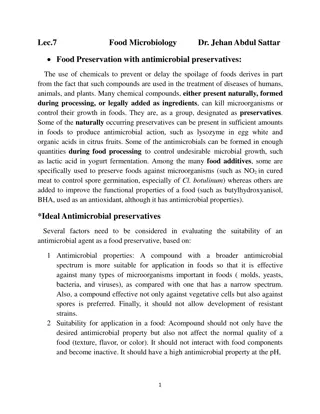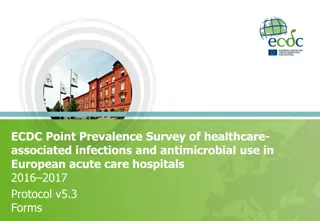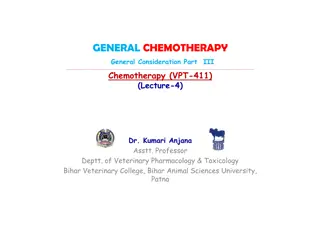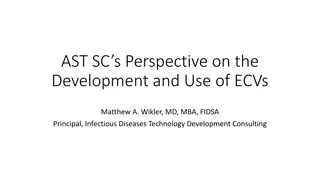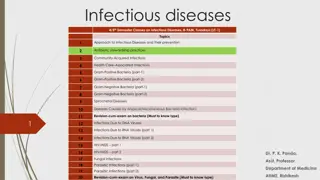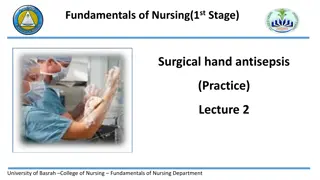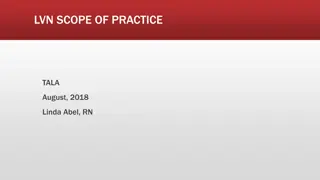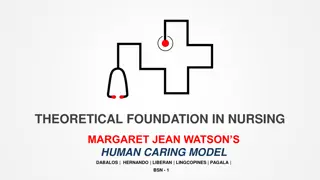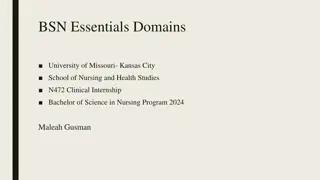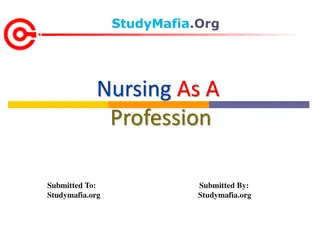Understanding Antimicrobial Stewardship in Nursing
Antimicrobial stewardship is crucial in combating antibiotic resistance and promoting appropriate use of antimicrobials. Nurses play a vital role as advocates for correct antibiotic use and are central in patient care, recognizing infections and adverse events. Core elements of antibiotic stewardship programs focus on improving patient outcomes, decreasing resistance, and saving healthcare costs. The nursing role includes medication reconciliation to ensure accurate documentation and reduce risks associated with antibiotic use.
- Antimicrobial Stewardship
- Nursing Role
- Antibiotic Resistance
- Patient Advocacy
- Medication Reconciliation
Download Presentation

Please find below an Image/Link to download the presentation.
The content on the website is provided AS IS for your information and personal use only. It may not be sold, licensed, or shared on other websites without obtaining consent from the author. Download presentation by click this link. If you encounter any issues during the download, it is possible that the publisher has removed the file from their server.
E N D
Presentation Transcript
Antimicrobial Stewardship for Nurses #keepcalmandstewardon
What is Antimicrobial Stewardship?1 Antibiotic resistance one of the top five health threats in the US per CDC National Action Plan for Combating Antibiotic Resistant Bacteria released by White House in March 2015 o Executive order by President Barack Obama o Outlined federal actions taken over next 5 years to slow emergence of resistant bacteria o Antibiotic stewardship programs mandatory in all acute-care hospitals by 2020 1. Manning, Mary Lou. "Antibiotic Stewardship for Staff Nurses." American Nurse Today, May 2016, www.americannursetoday.com/ antibiotic- stewardship-staff-nurses/.
What is Antimicrobial Stewardship? 1 Coordinated program promoting the appropriate use of antimicrobials Goals: o Improve patient outcomes o Decrease adverse events o Reduce microbial resistance o Decrease spread of infections caused by multidrug-resistant organisms (MDR) o Save healthcare dollars RIGHT antibiotic, at the RIGHT dose, administered by the RIGHT route for the RIGHT duration 1. "Antimicrobial Stewardship." Association for Professionals in Infection Control and Epidemiology (APIC), apic.org/Professional-Practice/Practice- Resources/Antimicrobial-Stewardship.
Core Elements of Antibiotic Stewardship Programs 1 1. "Core Elements of Hospital Antibiotic Stewardship Programs." Centers of Disease Control and Prevention (CDC), 7 May 2015, www.cdc.gov/getsmart/healthcare/implementation/core-elements.html.
The Vital Role of the Nurse 1 Nurses are at the center of patient care. o Last line before antibiotic administration o Therefore, important that they are advocates for correct antibiotic use Spend more time with patients than any other HCP o Recognizing catheter and line infections o Recognizing adverse events 1. Olans RN, Olans RD, DeMaria A., Jr. The critical role of the staff nurse in antimicrobial stewardship unrecognized, but already there. Clin Infect Dis 2016;62:84-
Nursing Role: Medication Reconciliation 1,2 Ensure accurate documentation of medication allergy history o Differentiating between true allergy and an adverse event o Penicillin allergies associated with increased costs, increased selection of antibiotic resistance microbes, increased lense of stay and increased hospital costs. Reconciling antibiotics during all patient-care transitions o Verify all antibiotics have an indication at transition points Allergy Hives or red, itchy patches Swollen, red, itchy rash Difficulty breathing Swelling in face, tongue, lips and/or throat Difficulty swallowing 1. Olans RN, Olans RD, DeMaria A., Jr. The critical role of the staff nurse in antimicrobial stewardship unrecognized, but already there. Clin Infect Dis 2016;62:84- "Allergy or adverse effect: Teach patients the difference." APhA, 1 Mar. 2014, www.pharmacist.com/allergy-or-adverse-effect-teach-patients- difference. 2.
Nursing Role: Prevention 1 Standard precautions o Hand hygiene, personal protective equipment (PPE), etc. Preventing catheter-associated urinary tract infection (CAUTI) and central line-associated bloodstream infection (CLABSI) o Preventing inappropriate use o Timely removal o Proper aseptic technique 1. Olans RN, Olans RD, DeMaria A., Jr. The critical role of the staff nurse in antimicrobial stewardship unrecognized, but already there. Clin Infect Dis 2016;62:84-
Nursing Role: Regimen and Review 1 Understand why patient is receiving an antibiotic o Antibiotics are sometimes continued unnecessarily because clinicians are not sure why it was initiated. Reviewing regimen length o Regimen length will vary by indication. For standard sepsis usually 7-10 days Reassessing therapy in 2 to 3 days o Antibiotics initiated before full clinical picture is known o Usually within 2 to 3 days, more information regarding microbiology and clinical status becomes known De-escalation Discontinuation 1. Manning, Mary Lou. "Antibiotic Stewardship for Staff Nurses." American Nurse Today, May 2016, www.americannursetoday.com/ antibiotic- stewardship-staff-nurses/.
Nursing Role: Proper Use and Administration 1 Ensure timely antibiotic administration o Critical in improving patient outcome. In septic patients, every hour delay in antibiotic administration is associated with a 4% increased risk of death Evaluate whether route of administration is appropriate o Early switch from IV to oral antibiotic therapy reduces length of stay and reduces risk of infection from IV access o Questions to ask: Is patient able to take oral meds? No nausea, vomiting? Is patient no longer on pressors? Does patient s clinical picture appear to be improving (i.e. fever coming down?) 1. Manning, Mary Lou. "Antibiotic Stewardship for Staff Nurses." American Nurse Today, May 2016, www.americannursetoday.com/ antibiotic- stewardship-staff-nurses/.
Image result for antibiotic cartoon Nursing Role: Monitoring 1 Monitor for infections o Colored sputum, dirty urine, skin infections etc. o CLABSI o CAUTI Monitor for antibiotic side effects 1. Olans RN, Olans RD, DeMaria A., Jr. The critical role of the staff nurse in antimicrobial stewardship unrecognized, but already there. Clin Infect Dis 2016;62:84-
